Unemployment as a Social Problem: Causes, Rates, and Policy Outcomes
VerifiedAdded on 2023/06/10
|6
|1092
|270
Essay
AI Summary
This essay examines unemployment as a significant social problem, defining it as the state of individuals willing to work but lacking employment, including those laid-off or dissatisfied with their current jobs. It delves into the sources of unemployment, such as high population, skill mismatches, weak labor policies, limited financial resources for entrepreneurship, and poor governance. The essay presents current global unemployment rates, highlighting Africa as having the highest rates, followed by Europe and the Americas. It also analyzes the unemployment social problem process through six stages: claimsmaking, media coverage, public reaction, policy making, social problems networks, and policy outcomes. Claimmakers include young and middle-aged job seekers, trade unions, and NGOs. The essay concludes that current policies are inadequate, often addressing future problems rather than immediate needs, leading to continued public demand for more effective employment solutions. Desklib provides students access to similar essays and study resources.
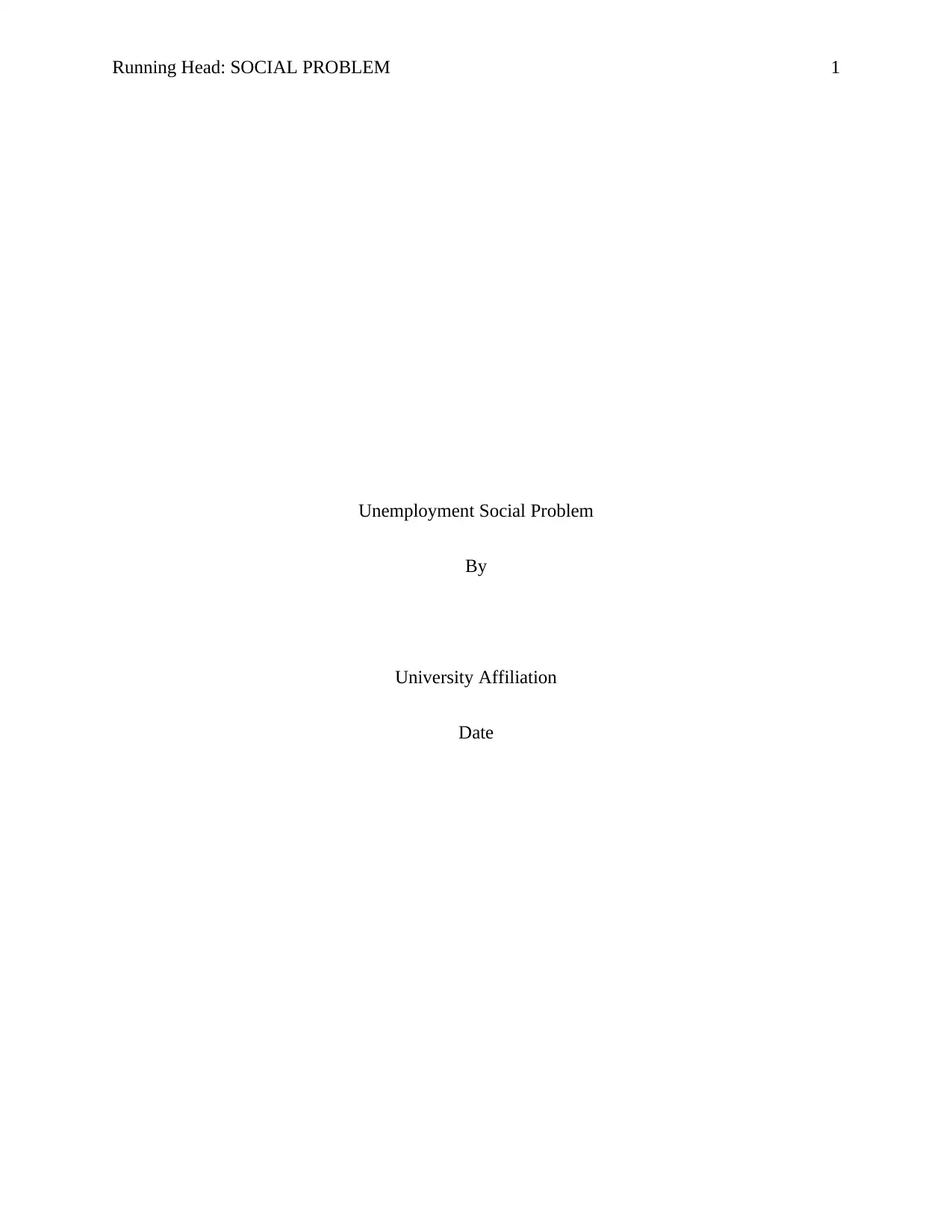
Running Head: SOCIAL PROBLEM 1
Unemployment Social Problem
By
University Affiliation
Date
Unemployment Social Problem
By
University Affiliation
Date
Paraphrase This Document
Need a fresh take? Get an instant paraphrase of this document with our AI Paraphraser
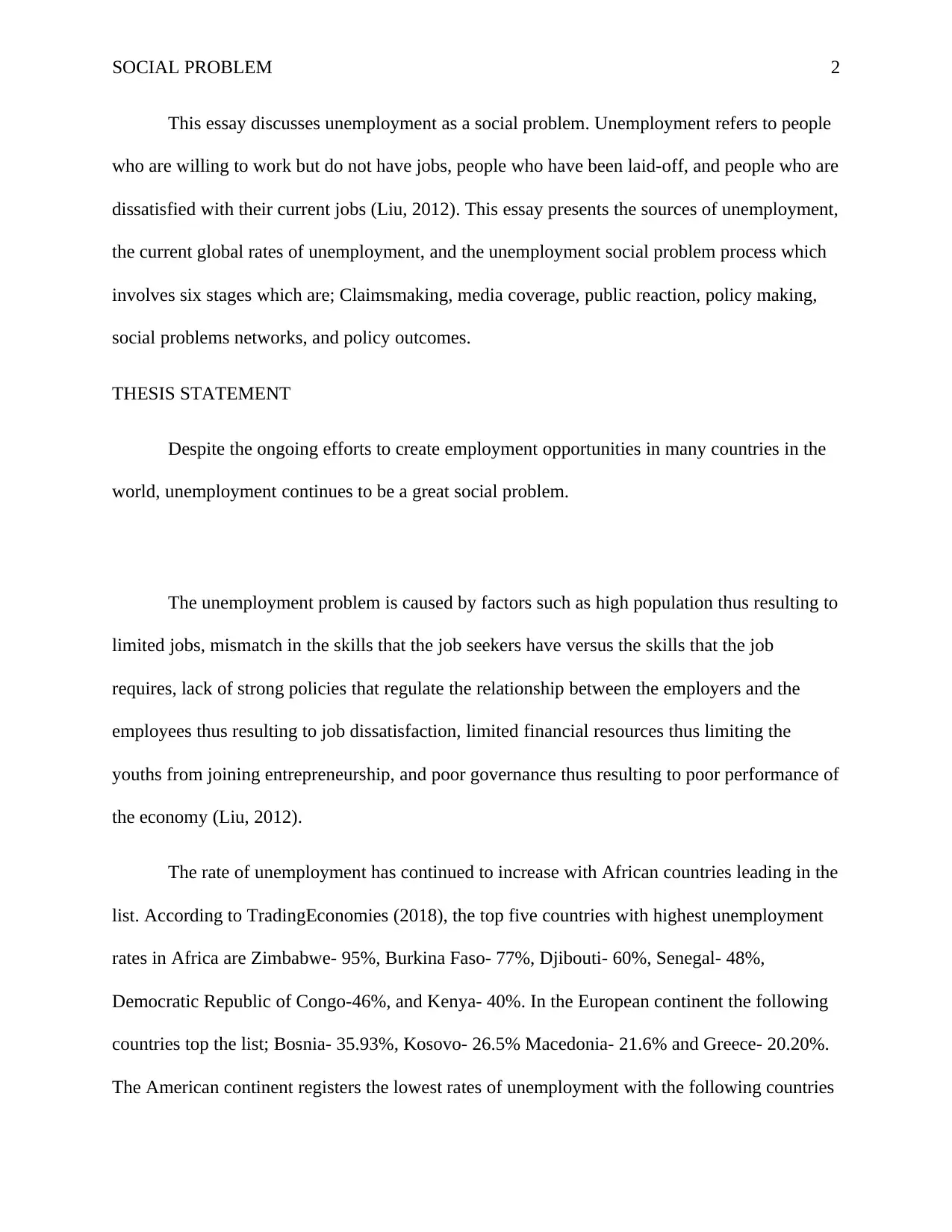
SOCIAL PROBLEM 2
This essay discusses unemployment as a social problem. Unemployment refers to people
who are willing to work but do not have jobs, people who have been laid-off, and people who are
dissatisfied with their current jobs (Liu, 2012). This essay presents the sources of unemployment,
the current global rates of unemployment, and the unemployment social problem process which
involves six stages which are; Claimsmaking, media coverage, public reaction, policy making,
social problems networks, and policy outcomes.
THESIS STATEMENT
Despite the ongoing efforts to create employment opportunities in many countries in the
world, unemployment continues to be a great social problem.
The unemployment problem is caused by factors such as high population thus resulting to
limited jobs, mismatch in the skills that the job seekers have versus the skills that the job
requires, lack of strong policies that regulate the relationship between the employers and the
employees thus resulting to job dissatisfaction, limited financial resources thus limiting the
youths from joining entrepreneurship, and poor governance thus resulting to poor performance of
the economy (Liu, 2012).
The rate of unemployment has continued to increase with African countries leading in the
list. According to TradingEconomies (2018), the top five countries with highest unemployment
rates in Africa are Zimbabwe- 95%, Burkina Faso- 77%, Djibouti- 60%, Senegal- 48%,
Democratic Republic of Congo-46%, and Kenya- 40%. In the European continent the following
countries top the list; Bosnia- 35.93%, Kosovo- 26.5% Macedonia- 21.6% and Greece- 20.20%.
The American continent registers the lowest rates of unemployment with the following countries
This essay discusses unemployment as a social problem. Unemployment refers to people
who are willing to work but do not have jobs, people who have been laid-off, and people who are
dissatisfied with their current jobs (Liu, 2012). This essay presents the sources of unemployment,
the current global rates of unemployment, and the unemployment social problem process which
involves six stages which are; Claimsmaking, media coverage, public reaction, policy making,
social problems networks, and policy outcomes.
THESIS STATEMENT
Despite the ongoing efforts to create employment opportunities in many countries in the
world, unemployment continues to be a great social problem.
The unemployment problem is caused by factors such as high population thus resulting to
limited jobs, mismatch in the skills that the job seekers have versus the skills that the job
requires, lack of strong policies that regulate the relationship between the employers and the
employees thus resulting to job dissatisfaction, limited financial resources thus limiting the
youths from joining entrepreneurship, and poor governance thus resulting to poor performance of
the economy (Liu, 2012).
The rate of unemployment has continued to increase with African countries leading in the
list. According to TradingEconomies (2018), the top five countries with highest unemployment
rates in Africa are Zimbabwe- 95%, Burkina Faso- 77%, Djibouti- 60%, Senegal- 48%,
Democratic Republic of Congo-46%, and Kenya- 40%. In the European continent the following
countries top the list; Bosnia- 35.93%, Kosovo- 26.5% Macedonia- 21.6% and Greece- 20.20%.
The American continent registers the lowest rates of unemployment with the following countries
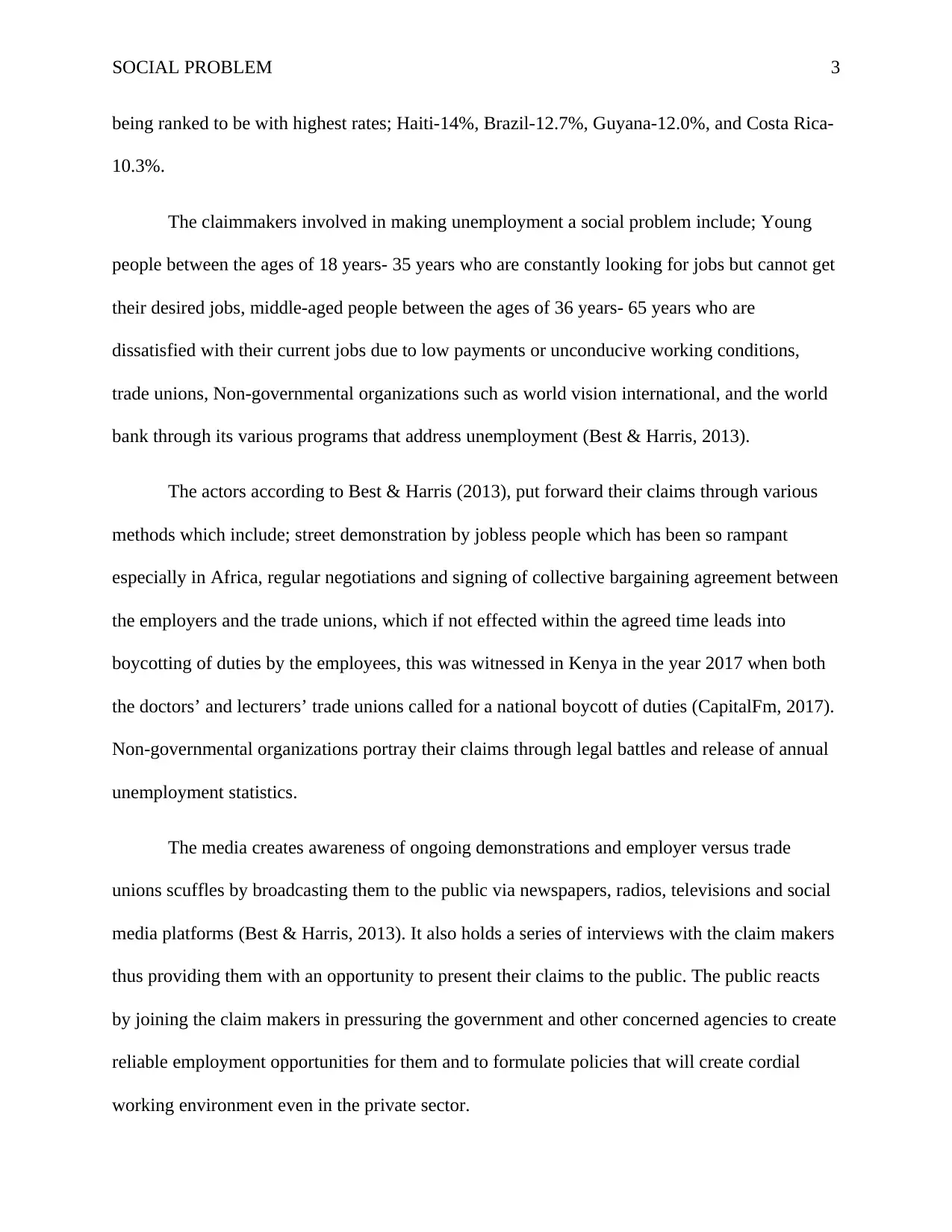
SOCIAL PROBLEM 3
being ranked to be with highest rates; Haiti-14%, Brazil-12.7%, Guyana-12.0%, and Costa Rica-
10.3%.
The claimmakers involved in making unemployment a social problem include; Young
people between the ages of 18 years- 35 years who are constantly looking for jobs but cannot get
their desired jobs, middle-aged people between the ages of 36 years- 65 years who are
dissatisfied with their current jobs due to low payments or unconducive working conditions,
trade unions, Non-governmental organizations such as world vision international, and the world
bank through its various programs that address unemployment (Best & Harris, 2013).
The actors according to Best & Harris (2013), put forward their claims through various
methods which include; street demonstration by jobless people which has been so rampant
especially in Africa, regular negotiations and signing of collective bargaining agreement between
the employers and the trade unions, which if not effected within the agreed time leads into
boycotting of duties by the employees, this was witnessed in Kenya in the year 2017 when both
the doctors’ and lecturers’ trade unions called for a national boycott of duties (CapitalFm, 2017).
Non-governmental organizations portray their claims through legal battles and release of annual
unemployment statistics.
The media creates awareness of ongoing demonstrations and employer versus trade
unions scuffles by broadcasting them to the public via newspapers, radios, televisions and social
media platforms (Best & Harris, 2013). It also holds a series of interviews with the claim makers
thus providing them with an opportunity to present their claims to the public. The public reacts
by joining the claim makers in pressuring the government and other concerned agencies to create
reliable employment opportunities for them and to formulate policies that will create cordial
working environment even in the private sector.
being ranked to be with highest rates; Haiti-14%, Brazil-12.7%, Guyana-12.0%, and Costa Rica-
10.3%.
The claimmakers involved in making unemployment a social problem include; Young
people between the ages of 18 years- 35 years who are constantly looking for jobs but cannot get
their desired jobs, middle-aged people between the ages of 36 years- 65 years who are
dissatisfied with their current jobs due to low payments or unconducive working conditions,
trade unions, Non-governmental organizations such as world vision international, and the world
bank through its various programs that address unemployment (Best & Harris, 2013).
The actors according to Best & Harris (2013), put forward their claims through various
methods which include; street demonstration by jobless people which has been so rampant
especially in Africa, regular negotiations and signing of collective bargaining agreement between
the employers and the trade unions, which if not effected within the agreed time leads into
boycotting of duties by the employees, this was witnessed in Kenya in the year 2017 when both
the doctors’ and lecturers’ trade unions called for a national boycott of duties (CapitalFm, 2017).
Non-governmental organizations portray their claims through legal battles and release of annual
unemployment statistics.
The media creates awareness of ongoing demonstrations and employer versus trade
unions scuffles by broadcasting them to the public via newspapers, radios, televisions and social
media platforms (Best & Harris, 2013). It also holds a series of interviews with the claim makers
thus providing them with an opportunity to present their claims to the public. The public reacts
by joining the claim makers in pressuring the government and other concerned agencies to create
reliable employment opportunities for them and to formulate policies that will create cordial
working environment even in the private sector.
⊘ This is a preview!⊘
Do you want full access?
Subscribe today to unlock all pages.

Trusted by 1+ million students worldwide
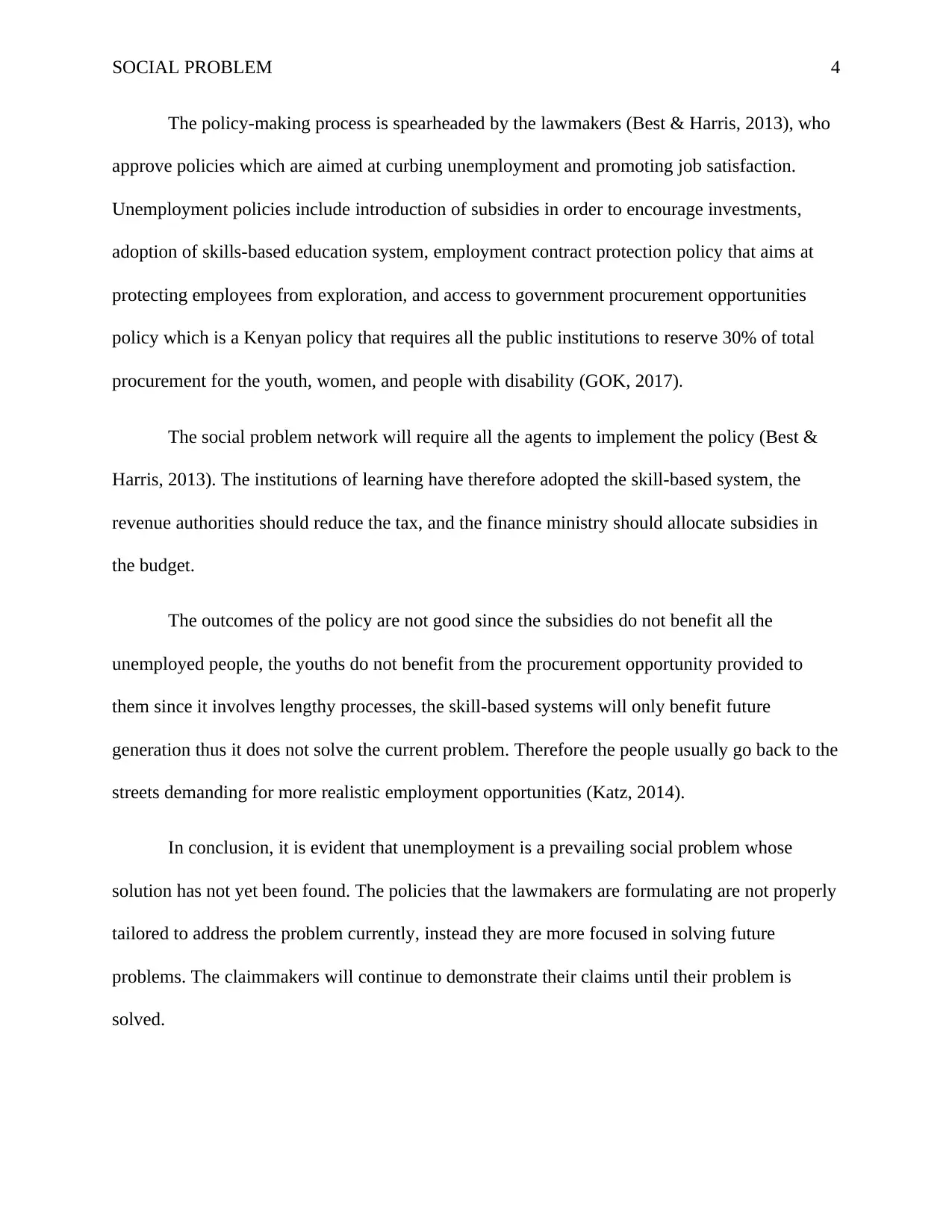
SOCIAL PROBLEM 4
The policy-making process is spearheaded by the lawmakers (Best & Harris, 2013), who
approve policies which are aimed at curbing unemployment and promoting job satisfaction.
Unemployment policies include introduction of subsidies in order to encourage investments,
adoption of skills-based education system, employment contract protection policy that aims at
protecting employees from exploration, and access to government procurement opportunities
policy which is a Kenyan policy that requires all the public institutions to reserve 30% of total
procurement for the youth, women, and people with disability (GOK, 2017).
The social problem network will require all the agents to implement the policy (Best &
Harris, 2013). The institutions of learning have therefore adopted the skill-based system, the
revenue authorities should reduce the tax, and the finance ministry should allocate subsidies in
the budget.
The outcomes of the policy are not good since the subsidies do not benefit all the
unemployed people, the youths do not benefit from the procurement opportunity provided to
them since it involves lengthy processes, the skill-based systems will only benefit future
generation thus it does not solve the current problem. Therefore the people usually go back to the
streets demanding for more realistic employment opportunities (Katz, 2014).
In conclusion, it is evident that unemployment is a prevailing social problem whose
solution has not yet been found. The policies that the lawmakers are formulating are not properly
tailored to address the problem currently, instead they are more focused in solving future
problems. The claimmakers will continue to demonstrate their claims until their problem is
solved.
The policy-making process is spearheaded by the lawmakers (Best & Harris, 2013), who
approve policies which are aimed at curbing unemployment and promoting job satisfaction.
Unemployment policies include introduction of subsidies in order to encourage investments,
adoption of skills-based education system, employment contract protection policy that aims at
protecting employees from exploration, and access to government procurement opportunities
policy which is a Kenyan policy that requires all the public institutions to reserve 30% of total
procurement for the youth, women, and people with disability (GOK, 2017).
The social problem network will require all the agents to implement the policy (Best &
Harris, 2013). The institutions of learning have therefore adopted the skill-based system, the
revenue authorities should reduce the tax, and the finance ministry should allocate subsidies in
the budget.
The outcomes of the policy are not good since the subsidies do not benefit all the
unemployed people, the youths do not benefit from the procurement opportunity provided to
them since it involves lengthy processes, the skill-based systems will only benefit future
generation thus it does not solve the current problem. Therefore the people usually go back to the
streets demanding for more realistic employment opportunities (Katz, 2014).
In conclusion, it is evident that unemployment is a prevailing social problem whose
solution has not yet been found. The policies that the lawmakers are formulating are not properly
tailored to address the problem currently, instead they are more focused in solving future
problems. The claimmakers will continue to demonstrate their claims until their problem is
solved.
Paraphrase This Document
Need a fresh take? Get an instant paraphrase of this document with our AI Paraphraser
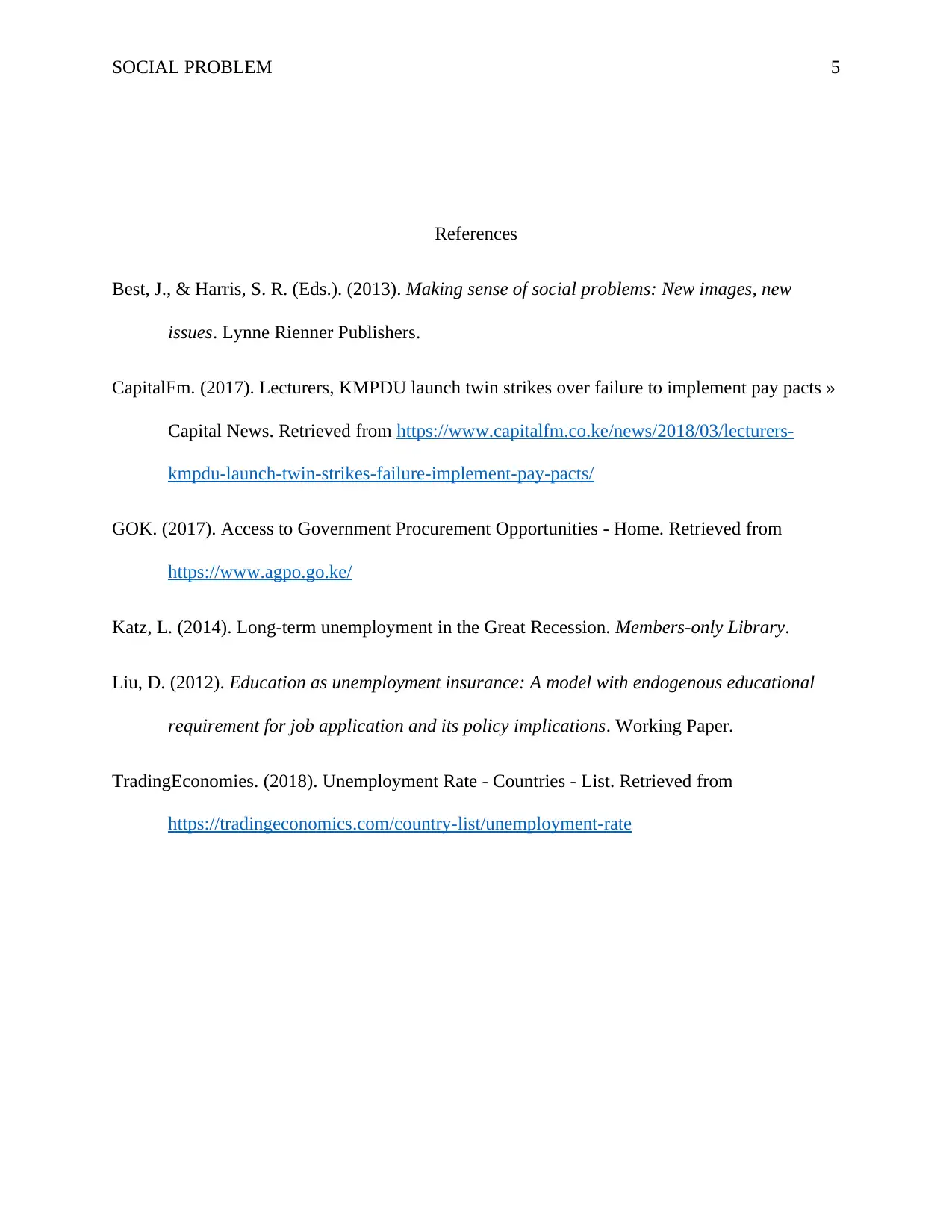
SOCIAL PROBLEM 5
References
Best, J., & Harris, S. R. (Eds.). (2013). Making sense of social problems: New images, new
issues. Lynne Rienner Publishers.
CapitalFm. (2017). Lecturers, KMPDU launch twin strikes over failure to implement pay pacts »
Capital News. Retrieved from https://www.capitalfm.co.ke/news/2018/03/lecturers-
kmpdu-launch-twin-strikes-failure-implement-pay-pacts/
GOK. (2017). Access to Government Procurement Opportunities - Home. Retrieved from
https://www.agpo.go.ke/
Katz, L. (2014). Long-term unemployment in the Great Recession. Members-only Library.
Liu, D. (2012). Education as unemployment insurance: A model with endogenous educational
requirement for job application and its policy implications. Working Paper.
TradingEconomies. (2018). Unemployment Rate - Countries - List. Retrieved from
https://tradingeconomics.com/country-list/unemployment-rate
References
Best, J., & Harris, S. R. (Eds.). (2013). Making sense of social problems: New images, new
issues. Lynne Rienner Publishers.
CapitalFm. (2017). Lecturers, KMPDU launch twin strikes over failure to implement pay pacts »
Capital News. Retrieved from https://www.capitalfm.co.ke/news/2018/03/lecturers-
kmpdu-launch-twin-strikes-failure-implement-pay-pacts/
GOK. (2017). Access to Government Procurement Opportunities - Home. Retrieved from
https://www.agpo.go.ke/
Katz, L. (2014). Long-term unemployment in the Great Recession. Members-only Library.
Liu, D. (2012). Education as unemployment insurance: A model with endogenous educational
requirement for job application and its policy implications. Working Paper.
TradingEconomies. (2018). Unemployment Rate - Countries - List. Retrieved from
https://tradingeconomics.com/country-list/unemployment-rate

SOCIAL PROBLEM 6
⊘ This is a preview!⊘
Do you want full access?
Subscribe today to unlock all pages.

Trusted by 1+ million students worldwide
1 out of 6
Related Documents
Your All-in-One AI-Powered Toolkit for Academic Success.
+13062052269
info@desklib.com
Available 24*7 on WhatsApp / Email
![[object Object]](/_next/static/media/star-bottom.7253800d.svg)
Unlock your academic potential
Copyright © 2020–2025 A2Z Services. All Rights Reserved. Developed and managed by ZUCOL.





